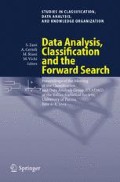Abstract
This paper outlines innovative techniques for the segmentation of consumer markets. It compares a new self-controlled growing neural network with a recent growing k-means algorithm. A critical issue is the identification of the “right” number of clusters, which is externally validated by the JUMP-criterion. The empirical application counters several objections recently raised against the use of cluster analysis for market segmentation.
Access this chapter
Tax calculation will be finalised at checkout
Purchases are for personal use only
Preview
Unable to display preview. Download preview PDF.
References
ARMSTRONG, J. S. (forthcoming): Persuasive Advertising. Palgrave New York.
BOONE, D.S. and ROEHM, M. (2002): Evaluating the Appropriateness of Market Segmentation Solutions Using Artificial Neural Networks and the Membership Clustering Criterion. Marketing Letters, 13(4). 317–333.
DECKER, R. (2005): Market Basket Analysis by Means of a Growing Neural Network. The International Review of Retail, Distribution and Consumer Research, 15(2), 151–169.
DING, C., HE, X., ZHA, H., and SIMON, H. (2002): Adaptive Dimension Reduction for Clustering High Dimensional Data. In: Proceedings of the 2nd IEEE International Conference on Data Mining. 147–154.
FENNEL, G., ALLENBY, G.M., YANG, S., and EDWARDS, Y. (2003): The Effectiveness of Demographic and Psychographic Variables for Explaining Brand and Product Category Use. Quantitative Marketing and Economics. 1(2). 223–244.
GRAPENTINE, T. and BOOMGAARDEN, R. (2003): Maladies of Market Segmentation. Marketing Research, 15(1), 27–30.
HAMERLY. G. and ELKAN. C. (2003): Learning the k in k-Means. In: Advances in Neural Information Processing Systems, 17.
MECKLIN, C. J. and MUNDFROM, D. J. (2004): An Appraisal and Bibliography of Tests for Multivariate Normality. International Statistical Review. 72(1). 123–138.
PUNJ, G. and STEWARD, D.W. (1983): Cluster Analysis in Marketing Research: Review and Suggestions for Application. Journal of Marketing Research, 20(May), 134–148.
SUGAR, C. A. and JAMES, G. M.(2003): Finding the Number of Clusters in a Dataset: An Information-theoretic Approach. Journal of the American Statistical Society, 98(463), 750–762.
SHETH, J.N. and SISODIA, R.S.(1999): Revisiting Marketing’s Lawlike Generalizations. Journal of the Academy of Marketing Science, 27(1), 71–87.
Author information
Authors and Affiliations
Editor information
Editors and Affiliations
Rights and permissions
Copyright information
© 2006 Springer-Verlag Heidelberg
About this paper
Cite this paper
Decker, R., Scholz, S.W., Wagner, R. (2006). Growing Clustering Algorithms in Market Segmentation: Defining Target Groups and Related Marketing Communication. In: Zani, S., Cerioli, A., Riani, M., Vichi, M. (eds) Data Analysis, Classification and the Forward Search. Studies in Classification, Data Analysis, and Knowledge Organization. Springer, Berlin, Heidelberg. https://doi.org/10.1007/3-540-35978-8_3
Download citation
DOI: https://doi.org/10.1007/3-540-35978-8_3
Publisher Name: Springer, Berlin, Heidelberg
Print ISBN: 978-3-540-35977-7
Online ISBN: 978-3-540-35978-4
eBook Packages: Mathematics and StatisticsMathematics and Statistics (R0)

